
Concept explainers
(a)
Interpretation: The product formed when the given compound in Problem 27.6 undergoes photochemical electrocyclic ring opening or ring closure is to be predicted. The given process is to be labeled as conrotatory or disrotatory. The stereochemistry around tetrahedral stereogenic centers and double bonds is to be indicated.
Concept introduction: Electrocyclic reactions involve the conversion of
Curved arrows aid in determining the movement and flow of electrons in the reaction. The electrons that take part in the
Answer to Problem 27.8P
The product formed in the given photochemical electrocyclic ring closure reaction is
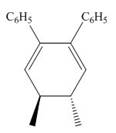
Explanation of Solution
The thermal electrocyclic ring closure reaction is shown below.
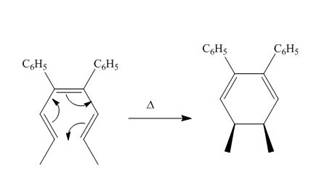
Figure 1
Electrocyclic reactions involve the conversion of
Under photochemical condition, conrotatory process takes place in the given reaction. The orientation of substituents and stereochemistry around tetrahedral stereogenic centers and double bonds in the given reaction are shown below.
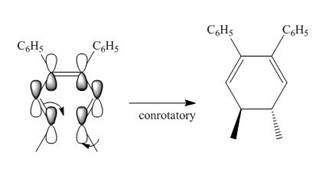
Figure 2
The conrotatory process involves the rotation of two orbitals in the same direction. The reaction in above figure implies that orbitals move in the same direction in the reactant molecule and the formation of trans product occurs. One methyl group is present above the plane and one methyl group is present below the plane in the product. Therefore, the product formed in the given photochemical electrocyclic ring closure reaction is
The product formed in the given photochemical electrocyclic ring closure reaction is
(b)
Interpretation: The product formed when the given compound in Problem 27.6 undergoes photochemical electrocyclic ring opening or ring closure is to be predicted. The given process is to be labeled as conrotatory or disrotatory. The stereochemistry around tetrahedral stereogenic centers and double bonds is to be indicated.
Concept introduction: Electrocyclic reactions involve the conversion of
Curved arrows aid in determining the movement and flow of electrons in the reaction. The electrons that take part in the chemical reactions are shown by the curved arrows.
Answer to Problem 27.8P
The product formed in the given photochemical electrocyclic ring opening reaction is

Explanation of Solution
The thermal electrocyclic ring opening reaction is shown below.
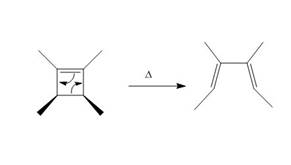
Figure 3
Electrocyclic reactions involve the conversion of
Under photochemical condition, disrotatory process takes place in the given reaction. The movement of substituents and stereochemistry around tetrahedral stereogenic centers and double bonds in the given reaction are shown below.
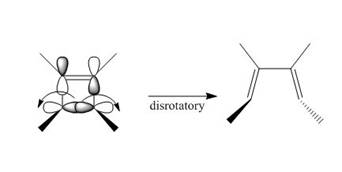
Figure 4
The disrotatory process involves the rotation of two orbitals in the opposite direction. The reaction in above figure implies that orbitals move in the opposite direction in the reactant molecule and the formation of trans product occurs. One methyl group is present above the plane and one methyl group is present below the plane in the product shows the stereochemistry. Therefore, the product formed in the given photochemical electrocyclic ring opening reaction is
The product formed in the given photochemical electrocyclic ring opening reaction is
Want to see more full solutions like this?
Chapter 27 Solutions
Organic Chemistry
- Optical active compound 1-chloro-3-methylcyclopentane was reacting withpotassium t-butoxide in t-butanol. Two alkene products were obtained. Themain product was optically active, and the secondary product was notoptically active. What are the two products?arrow_forwardWhat product is formed when each compound undergoes thermal electrocyclic ring opening or ring closure? Label each process as conrotatory or disrotatory and clearly indicate the stereochemistry around tetrahedral stereogenic centers and double bonds. CeHs a. b. CeH5arrow_forwardDraw the products formed when both cis- and trans-but-2-ene are treated with a peroxyacid followed by -OH (in H2O).Explain how these reactions illustrate that anti dihydroxylation is stereospecic.arrow_forward
- Draw the structure of an alkyl bromide with molecular formula CgH13Br that fits each description: (a) a 1° alkyl bromide with one stereogenic center; (b) a 2° alkyl bromide with two stereogenic centers; (c) an achiral 3° alkyl bromide.arrow_forwardPlease fill in the missing reactants, reagents or products in the following reactions. Indicate relative stereochemistry where it is necessary CI j)arrow_forwardPlease assign priority groups and assign R or S stereochemistry for eacharrow_forward
- (a) What product(s) are formed when the E isomer of C6H5CH = CHC6H5 is treated with Br2, followed by one equivalent of KOH? Label the resulting alkene(s) as E or Z. (b) What product(s) are formed when the Z isomer of C6H5CH = CHC6H5 is subjected to the same reaction sequence? (c) How are the compounds in parts (a) and (b) related to each other?arrow_forwardDraw the products formed in each reaction and indicate stereochemistry.arrow_forwardDraw the product of each Diels–Alder reaction, and indicate the stereochemistry at all stereogenic centers.arrow_forward
- Addition of HCl to alkene X forms two alkyl halides Y and Z. (A) Label Y and Z as a kinetic or thermodynamic product and explain why. (B) Explain why the addition of HCl occurs at the exocyclic C=C, rather than the other C=Carrow_forwardConsider the following chemical transformation:The transformation takes place via two sequential pericyclic reactions. Identify the two reactions and give a critical explanation whether the reactions are allowable or not. Explain the stereochemistryarrow_forwardFor alkenes A, B, C, and D: (a) Rank A—D in order of increasing heat ofhydrogenation; (b) rank A—D in order of increasing rate of reaction withH2, Pd-C; (c) draw the products formed when each alkene is treated withozone, followed by Zn, H2O.arrow_forward
